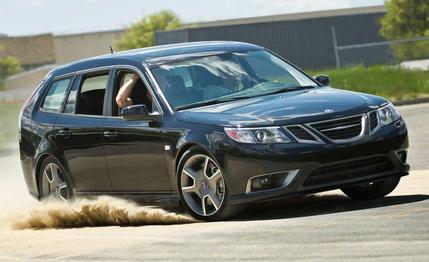
 Short Take Road Test
Short Take Road Test
As engine outputs have risen over the past 25 years, front-drive cars have migrated toward four-wheel drive to give their overburdened front tires a break. Even Saab has finally capitulated with this Turbo X version of the 9-3.
A Haldex 4.0 center coupling shifts as much as 90 percent of the engine’s 280-hp output to the rear wheels via electronically controlled wet clutches. Its little digital brain anticipates when power is needed in back even before the tires slip. An electronically controlled clutch pack in the rear differential prevents side-to-side slip, while the traction control takes care of the front wheels.
To exploit its enhanced traction, the Turbo X gets an uprated version of Saab’s turbocharged V-6. Boost pressure jumps 8.7 to 11.6 psi, pushing output from 255 horsepower to 280 and torque from 258 pound-feet to 295. And unlike the front-drive 9-3 models, there’s no torque limitation in first and second gears.
The Turbo X also gets bigger front brakes, a reworked suspension that sits 0.4 inch lower, self-leveling rear shocks, and special 18-inch wheels and tires. The cars are also all-black, inside and out, with a titanium finish on the grille and a thicker steering-wheel rim covered in perforated leather. They even have swiveling bixenon headlights that tilt up three degrees at speeds above 58 mph to increase the reach of the high-beams on the highway.
And one more thing—the Turbo X is exclusive. Only 600 cars came to America (most will have been sold by press time), and three-quarters of them are sedans, the other quarter wagons. Automatic transmissions will outnumber manuals by a similar ratio.
That makes the car seen here—a manual SportCombi wagon—the rarest of the breed. Saab touts it as the last of the performance wagons—at least until you get into the rich and rare Mercedes AMG varieties, but the Turbo X isn’t as quick.
Our test car barely broke 15 seconds in the quarter-mile and needed a full six seconds to hit 60 mph. We’re not quite sure how fast the Turbo X will go because during our top-speed run, the engine began to overheat around 145 mph. On the road, the Turbo X feels peppy, but you need to use the gearbox because you’ll notice turbo lag if you let the revs drop below 2000.
Cornering grip was also less than record-setting at 0.83 g. But the Turbo X has a taut feel on the road, and if you press it hard it rotates nicely when you ease the throttle near the cornering limit. The downside of this sporty suspension is a pogo-like hop on certain freeways and the occasional harshness over severe bumps.
As with other 9-3s, the Turbo X has a practical interior with plenty of luggage space and a usable rear seat. The overall driving position is very comfortable.
All of this comes at a rich price of about 45 grand if you pick any options. There are similar wagons to be had from Audi, BMW, and Infiniti, but Saab buyers seem to like the less ostentatious image of their cars.